The Google Nexus 6P Review
by Andrei Frumusanu on December 16, 2015 8:00 AM ESTSystem & CPU Performance
The Nexus 6P comes with a Snapdragon 810 designed by Qualcomm. This is a big.LITTLE 4x A53 @ 1.55GHz + 4x A57 @ 1.95GHz SoC. As we’ve hopefully come to be very familiar with the chipset over the last couple of months, the key characteristics with which the 6P can differentiate itself from other Snapdragon 810 devices is through software optimizations. In particular the fact that the Nexus 6P comes with Android 6.0 Marshmallow should allow it to be able to showcase some improvements which we’ll dive into a bit later.
First we start by comparing performance of some of our browser-based benchmarks. These are predominantly Javascript tests which require large single-core performance out of the device’s SoCs.
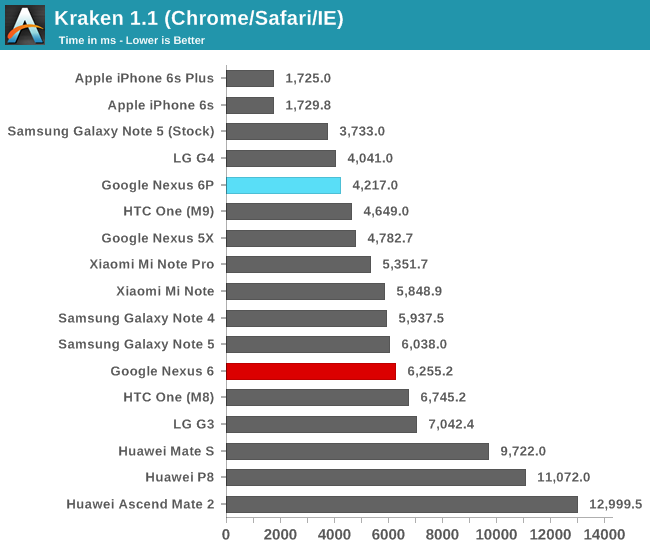
In Kraken the Nexus 6P is able to showcase a very good score that’s only beat by, oddly enough, the LG G4. As we’ve come to discover over the past year OEM browser libraries play a large role in device performance, even though we’re using the same Chrome build across different devices we see large differences in performance even within devices who employ the same SoC. It’s relatively unnerving to see this fragmentation in the ecosystem and in particular Chrome performing so differently across devices.
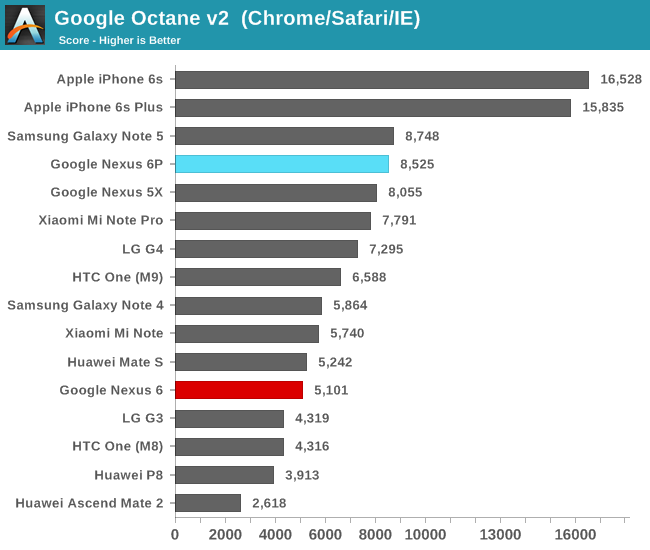
In Octane the Nexus 6P again performs very well, this time again beating our other devices such as the HTC One M9 or the Xiaomi Mi Note Pro. Among Android devices, only the Galaxy Note 5 - which on Octane is able to show equal performance as it does in its optimized stock browser - is able to beat it.
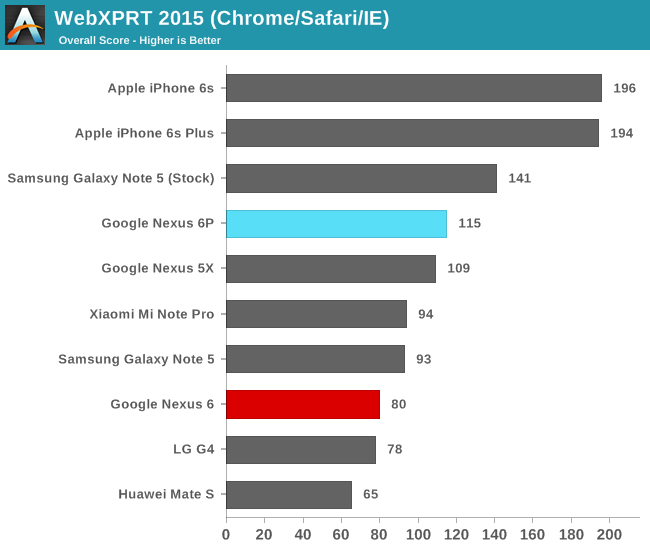
On WebXPRT again we see the 6P performs extremely well among Android devices, only being able to be beat by Samsung’s Exynos 7420 devices in the stock browser.
Continuing onto our system benchmarks, we start with Basemark OS II 2.0 from Basemark (formerly Rightware).

In the web test the Nexus 6P is yet again found at the high-end of the charts as it is able to provide good numbers. As we’ve seen in reviews such as on the Mate S it’s not necessarily raw performance that is demanded in these tests but also performance latency which plays a big role.
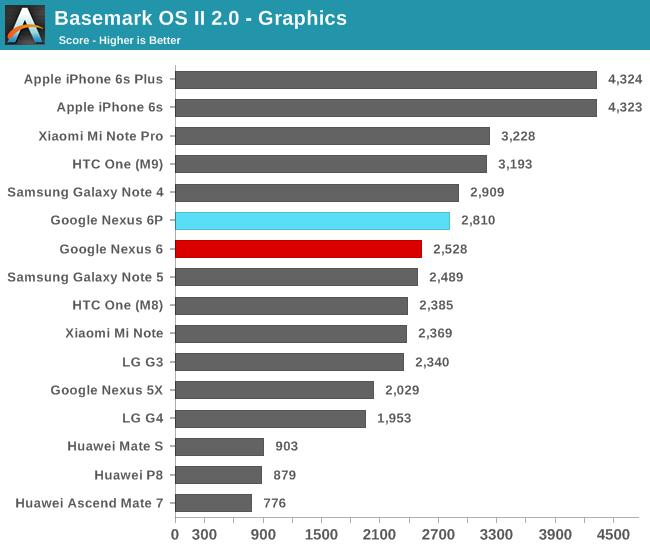
The graphics sub-test of Basemark has always been kind to the Adreno GPU so here again we see the Nexus 6P perform well, although not quite up to par with the other Snapdragon 810 devices we’ve tested in the past.
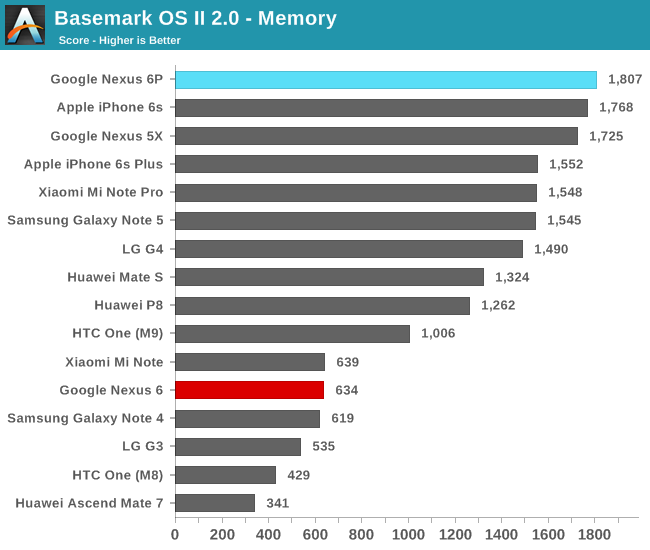
The Nexus 6P comes in a surprising first place on Basemark OS’s memory test. Again this is a mainly NAND-limited test but in contrast to our other synthetic test, performance and access patterns try to simulate more real-world applications.
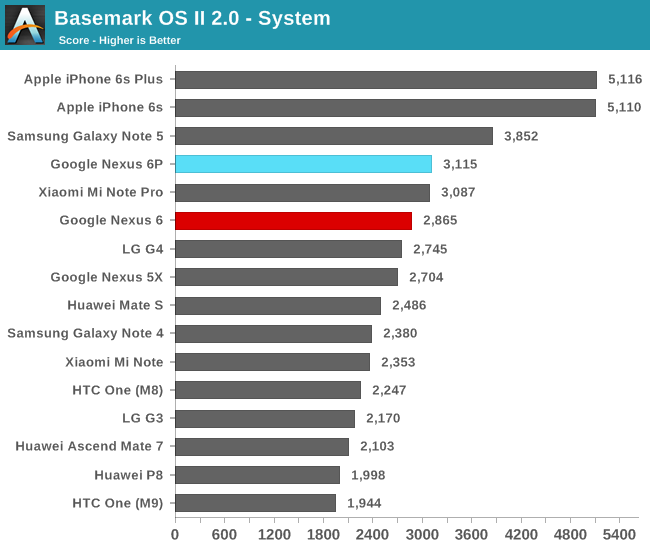
While the other tests try to test more realistic workloads, the system benchmark is all about measuring peak performance in a given set of scenarios. Here the Nexus 6P fares similarly to the Xiaomi Mi Note Pro but falls behind Exynos 7420 devices such as the Note 5.
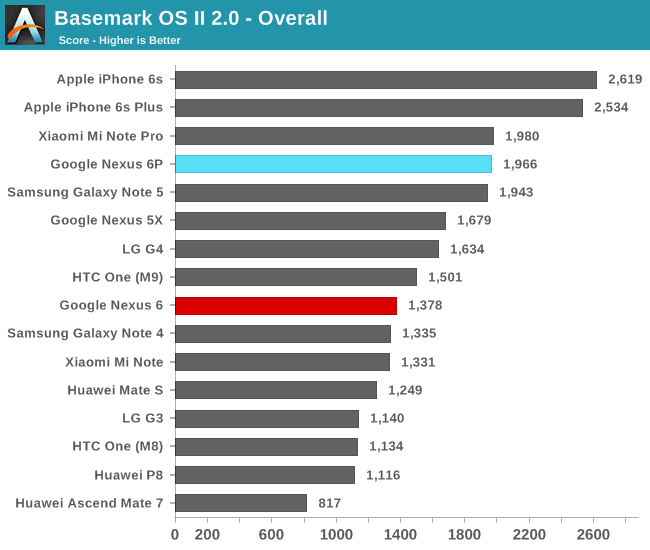
While I’m not a great fan of overall aggregate benchmark scores, we still see the Nexus 6P among the top of today’s currently available Android devices.
Moving on to PCMark from Futuremark, we’ll use a suite of tests that not only try to mimic real-world usage patterns, but actually make use of APIs that we currently find in use by many day-to-day applications.
Starting with the web browsing test we find the application use Android’s built-in WebView container which relies on OS-dependent components.
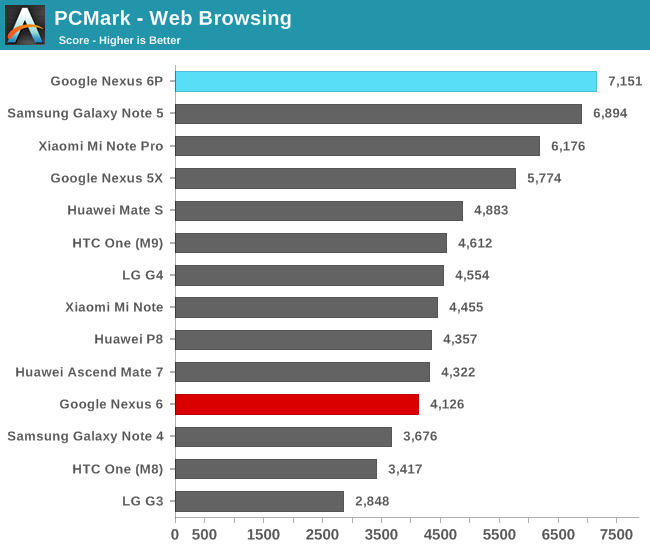
Here we see the Nexus 6P lead performance, slightly beating the Note 5. We’re also likely seeing advantages due to Android 6.0 as the Mi Note Pro, our other device with the Snapdragon 810 lags over a thousand points behind.

On the video playback score the Nexus 6P comes in towards the middle of the pack. The video test is a benchmark of both the video decoding hardware and software layers of the device, as well as the NAND speed, as fast seeking through the video is performed to test out how rapidly the device can resume playback.
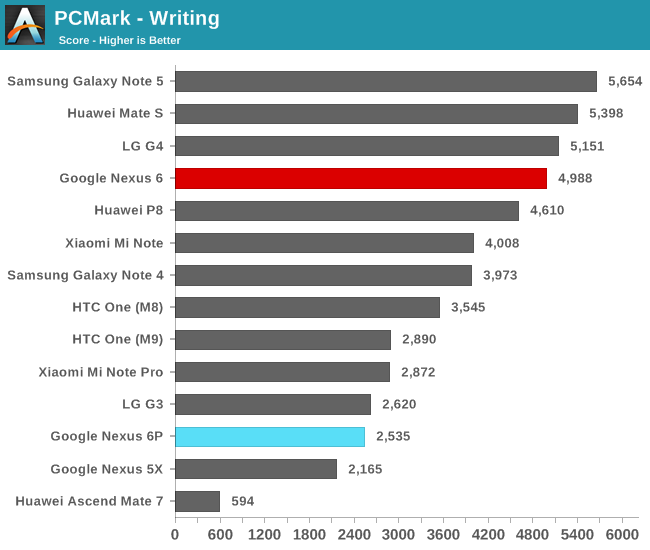
Now onto the writing test we come to one of the larger mysteries of the new Nexus 6’s performance. Both the Nexus 5X and the 6P seem to have large issues with PCMark’s writing test. The test itself consist of text manipulation and some file I/O, but most importantly it’s that this is purely a Java based test. Due to the way Android is architected, this means the code is handled and executed by the Android RunTime (ART). Futuremark have done a fantastic job in creating a test-case which is very sensitive to performance differences in the runtime.
At first when seeing these scores I thought that this was a side-effect of Android 6.0’s new big.LITTLE optimizations (which we’ll get back to in a later section), but even after turning those settings off the scores remained the same. After testing some other Java-based benchmarks I came to the conclusion that this has to be a software issue.
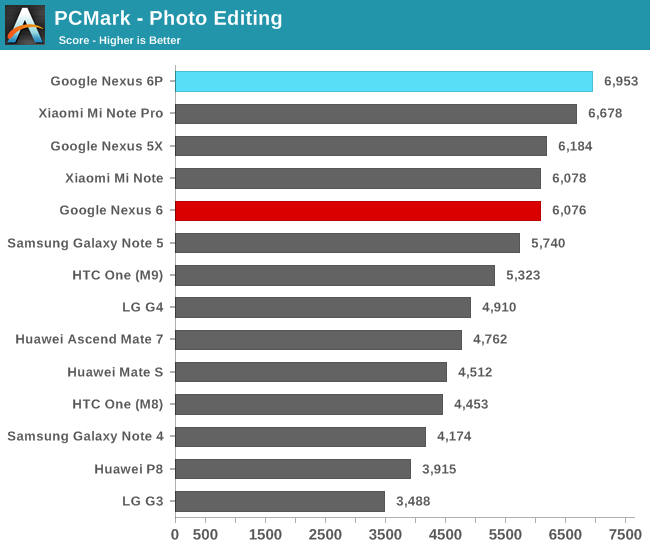
The photo editing uses RenderScript kernels to apply image processing on a set of pictures. With help of a powerful GPU the Nexus 6P performs top of the class
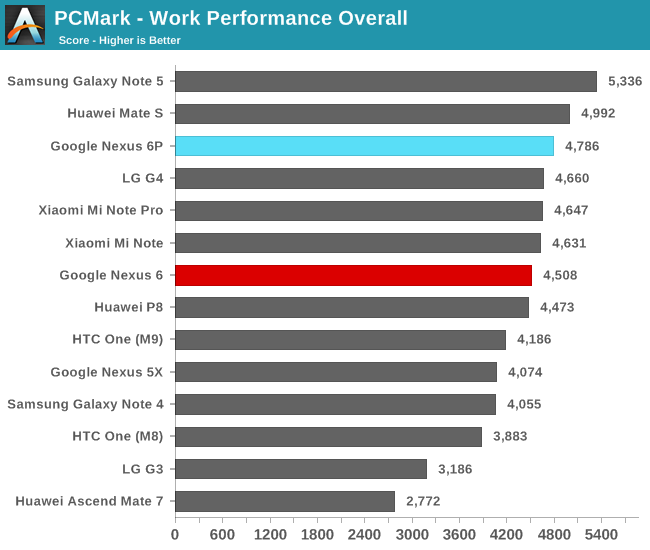
Due to the disappointing writing sub-score the Nexus 6P ends up third in the overall PCMark work performance score. Nevertheless, this is a good showing for the Snapdragon 810 device as it manages to slightly beat the Mi Note Pro and the HTC One M9.










219 Comments
View All Comments
Djdjndjddjs - Wednesday, December 16, 2015 - link
"even last year’s Snapdragon 801/805 phones" this here just made this review a whole lot less credible.grayson_carr - Thursday, December 17, 2015 - link
How so? He was referring to sustained performance (after throttling) and the Nexus 6P does indeed have a lower framerate than the One M8 (Snapdragon 801) in the GFXBench Sustained Performance test.tuxRoller - Wednesday, December 16, 2015 - link
So, the 6p does a better job than the note 5 at maintaining long-term graphics perf.grayson_carr - Thursday, December 17, 2015 - link
Looks like it. Weird that the Galaxy S6 did a better job than both though. You would think the Note 5 would do better than the S6... same SOC, but seemingly more room to dissipate heat.Sahrin - Wednesday, December 16, 2015 - link
Really important to see the carrier aggregation information for the radio as well, not just the band supported.bmullan - Wednesday, December 16, 2015 - link
The article was TLDR ... but in case the article didn't mention it.... These are the 2 Phones that Google has approved for its Project FI (https://fi.google.com/about/).The Nexus 6P is the one to get if you want to have the transparent auto-switching between 2 different Mobile Providers and also auto-switching with wifi. The Nexus 6 only gets you transparent auto-switching between 1 mobile provider & wifi.
rstuart - Wednesday, December 16, 2015 - link
I bought a 6P a while ago, so I read the article more to get a feel for how well it matches my own thoughts about the phone.Overall, it does. Even it's comments on price are pretty well spot on - I live outside of the US, and if I had to pay for it there is no way I could justify it, even though I happen to prefer stock Android.
I was particularly pleased to see how Qualcomm's clusterfuck, the 810 was presented. There is simply no excuse for producing a SoC that is worse than the previous generation in terms of performance/watt, and yet that is what Quallcomm did. Yet amazingly, Huawei (mostly through the large battery) and Google (using software tricks to keep the thing switched off) managed to mitigate that and produce a device that has a very usable battery life.
Subjectively in everyday use the 6P is very fast, just as the review says. And yes the screen is excellent, although it would be just as good if they dropped the resolution by 1/3 to retina levels and reduced the load off the GPU. The form fact is perfect for a phablet - the screen is large but you can still comfortably operate it with one hand. (Hint Andrei: that is why the buttons are in the middle. You could not reach them if they were on the top. And yes, making them reachable when you pick it up with one hand also means you bump them occasionally.)
It's a pity Andrei didn't comment on USB-C. I make a point of handing the phone plus USB-C cable over to people and you can hear an audible sigh of joy from some as they realise the mental effort of orientating the connect has gone. The connector with its definite click as you push it home is a delight to use. And he neither does he mention the down side - USB-C to traditional USB adaptors is a mess, and as a result you can forget getting those excellent charging results from any of your non USB-C chargers. Instead you get the base rate of 0.5A 5V charging regardless of what your charger is capable of, which means when I'm using the phone for navigation in the car the battery discharges even though plugged in. And there is no wireless charging.
My overall feeling is it is a wonderful phone, the occasional wart doesn't harm the experience. Amazing, given given the clusterfuck of a SoC Huawei and Google had to work with. Still, if I was in a position to wait 12 months I'd be waiting. The 820 is not only back on trend in the performance/watt stakes, it also has a much better LTE modem and it looks like those extra LTE bands international version has is what took the price from "reasonable" to "badly overpriced".
silverblue - Thursday, December 17, 2015 - link
My upgrade is due next Wednesday, and I've been looking at this phone with more than a passing interest, however one or two sites out of the (very happy, I might add) maddening crowd don't appear to be too complimentary about it. We've got a 950 XL here for testing so I'm waiting for more news on that despite the slagging off it's been getting from the press, and I suppose I don't have to upgrade on the deadline day, however there is the small matter of a free £50 Google Play voucher until the 24th which makes it all the more tempting. Additionally, whereas the Note 5 would seem like a good alternative, I'm hearing a lot made about its availability and price, plus Samsung's incessant desire to tell you that their vision of Android is the correct one, and the aforementioned memory management issue, so I'm not considering the Note 5 at this time. Had this review been more positive, I think my mind would've been made up.I could always just wait another month. January sales, and all that.
silverblue - Thursday, December 17, 2015 - link
Of course, the voucher is applicable to the 6P. :) There's also the small matter of the non-availability of the free dock on the 950 series, but then again, it's not as if I'm going to use a phone to do all my work on.grayson_carr - Thursday, December 17, 2015 - link
Your point about only getting the base rate of 0.5A from non USB-C chargers is not correct. Using an Anker charger in my care with the USB A to C cable from the Google Store gets me near 2A, which isn't as fast as the 3A provided by the USB C charger included in the box, but is still fairly fast.